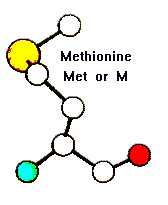

For an updated version of these pages, click here


Substitution preferences:
All protein types:
| Favoured | Leu ( 2) | Ile ( 1) | Val ( 1) | |||||
| Neutral | Gln ( 0) | Phe ( 0) | ||||||
| Disfavoured | Ala (-1) | Ser (-1) | Cys (-1) | Lys (-1) | Thr (-1) | Arg (-1) | Trp (-1) | Tyr (-1) |
| Asn (-2) | Pro (-2) | Glu (-2) | His (-2) | Asp (-3) | Gly (-3) |
| Favoured | Leu ( 2) | Ile ( 1) | Phe ( 1) | |||||
| Neutral | Ala ( 0) | Cys ( 0) | Arg ( 0) | Gln ( 0) | Lys ( 0) | Thr ( 0) | Val ( 0) | Trp ( 0) |
| Tyr ( 0) | ||||||||
| Disfavoured | Glu (-1) | His (-1) | Asn (-1) | Pro (-1) | Ser (-1) | Gly (-2) | Asp (-2) |
| Favoured | Leu ( 1) | |||||||
| Neutral | Ala ( 0) | Val ( 0) | Thr ( 0) | Arg ( 0) | Glu ( 0) | Phe ( 0) | Gln ( 0) | Ile ( 0) |
| Disfavoured | His (-1) | Lys (-1) | Asn (-1) | Pro (-1) | Ser (-1) | Trp (-1) | Tyr (-1) | Gly (-2) |
| Asp (-2) | Cys (-5) |
| Favoured | Ile ( 1) | Val ( 1) | Leu ( 1) | |||||
| Neutral | Arg ( 0) | Phe ( 0) | Thr ( 0) | |||||
| Disfavoured | Lys (-1) | Ala (-1) | Cys (-1) | Asn (-2) | Ser (-2) | Gln (-2) | Trp (-2) | His (-3) |
| Tyr (-3) | Asp (-3) | Pro (-3) | Glu (-3) | Gly (-3) |
Role in structure: Being hydrophobic, Methionine prefers to be buried in protein hydrophobic cores.
Role in function: The Methionine side chain is fairly non-reactive, and is thus rarely directly involved in protein function. Like other hydrophobic amino acids, it can play a role in binding/recognition of hydrophobic ligands such as lipids.
Unlike the proper aliphatic amino acids, Methionine contains a sulphur atom, that can be involved in binding to atoms such as metals. However, whereas the sulphur atom in Cysteine is connected to a hydrogen atom, making it quite reactive, Methionines sulphur is connected to a methyl group. This means that the roles that Methionine can play in protein function are much more limited.